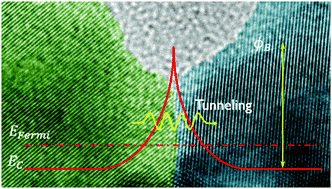Electron tunneling through grain boundaries in transparent conductive oxides and implications for electrical conductivity: the case of ZnO:Al thin films†
Abstract
In this work, we have applied the Airy Function Transfer-Matrix Method to provide a numerical description of the charge scattering mechanisms taking place at the grain boundaries in polycrystalline, degenerately Al-doped ZnO (ZnO:Al) films, one of the most studied Transparent Conductive Oxides (TCOs). By discretizing the potential barrier at the grain boundary into linear segments, an accurate calculation of the electron tunneling probability through the grain boundaries has been obtained. Conversely to analytical models based on the Wentzel–Kramers–Brillouin (WKB) approximation, our new approach is valid for any doping level. We thus provide a complete model that allows a comprehensive explanation of carrier transport in highly doped semiconductors, for which charge tunneling across grain boundaries cannot be neglected. We have tested our model with ZnO:Al thin films prepared by different physical and chemical deposition techniques, namely, sputtering, atomic layer deposition and atmospheric pressure spatial atomic layer deposition. A linear relationship between the trap density at the grain boundaries and carrier density has been extracted by fitting our model to Hall mobility data for the different samples. Our results provide guidance on how to adapt the deposition conditions to obtain high-quality materials, with an optimum ratio between optical and electrical properties as required for specific applications.



 Please wait while we load your content...
Please wait while we load your content...